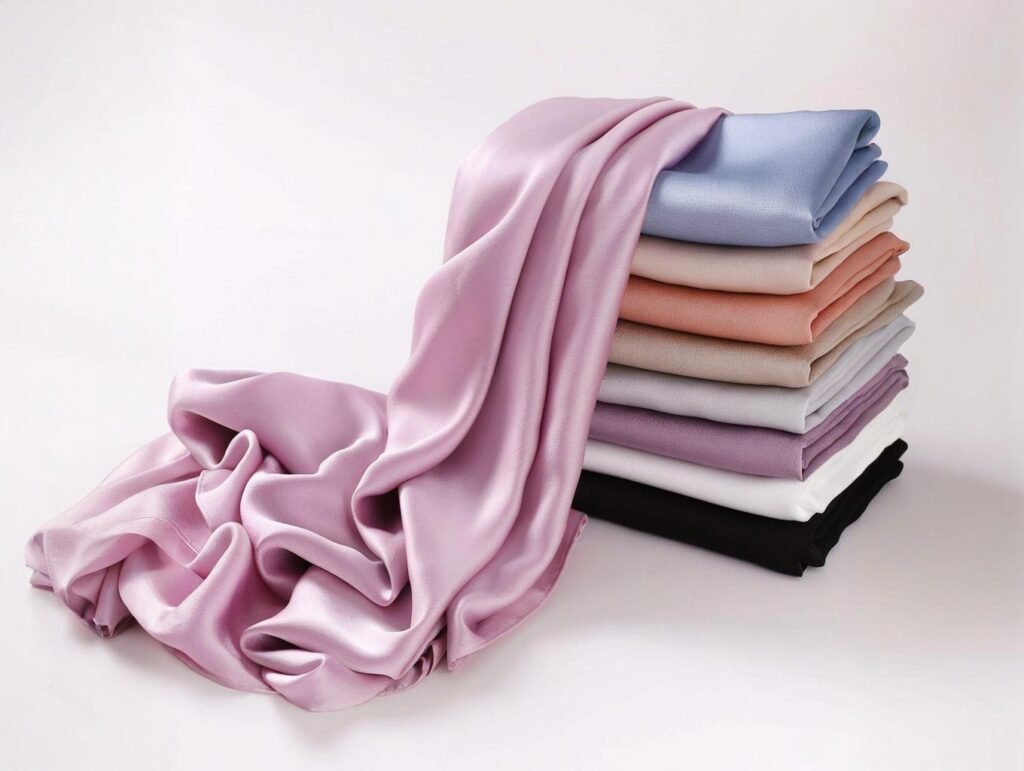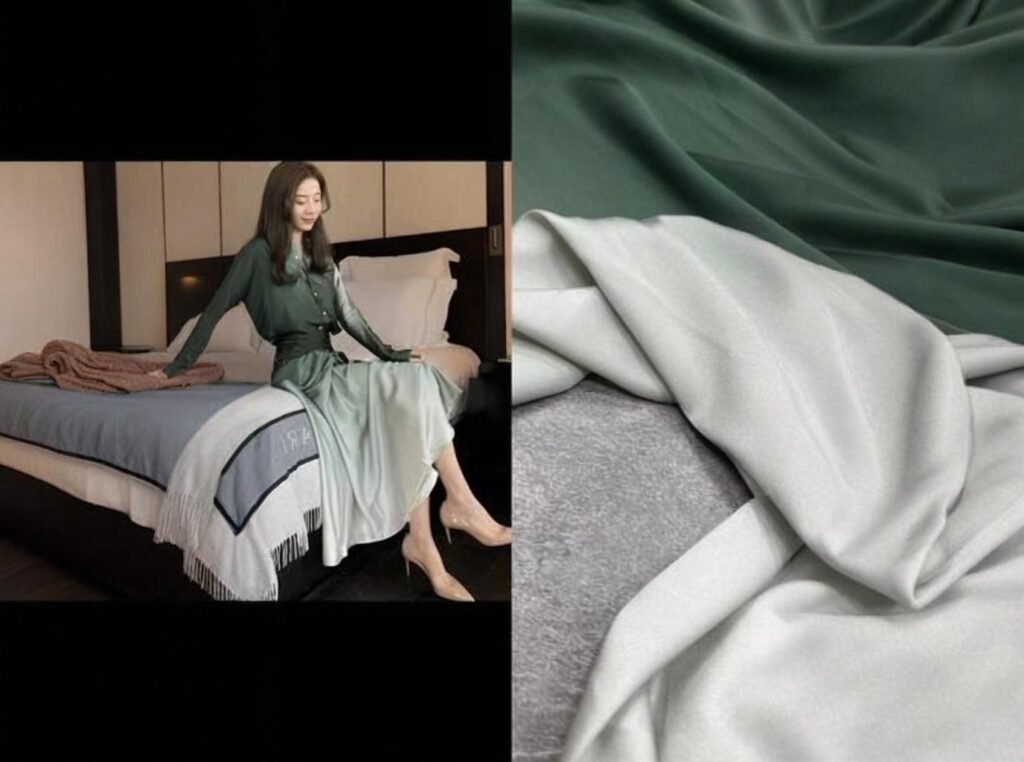The fashion world in 2025 is embracing a shift that blends tradition with innovation—and at the heart of it lies a textile that offers the best of both worlds: cotton silk fabric. As consumers prioritize both natural feel and elegant sheen, this hybrid textile is emerging as a favorite for brands seeking comfort without compromising on luxury. Whether it’s for warm-weather resort wear, elevated loungewear, or heritage-inspired ethnic garments, cotton silk is rising through the ranks—not as a substitute, but as a statement of balance. Cotton silk fabric is gaining popularity in 2025 due to its blend of softness, breathability, and luxury appeal, offering an ideal mix for both fashion and lifestyle applications.
Behind the rise in demand is a combination of design flexibility, lower production cost than pure silk, and increasing access to eco-certified sourcing. This trend isn’t just aesthetic—it’s strategic, especially for creators looking to meet the modern demand for fabric performance, affordability, and traceability.
In this article, we’ll unpack exactly how the cotton silk market is evolving in 2025, and what it means for fabric selection in the coming seasons.
What Is Cotton Silk Fabric and Why Is It Gaining Popularity in 2025?

Cotton silk is a blended textile typically made by combining 70–50% cotton and 30–50% silk, designed to deliver both the breathability and softness of cotton and the luster and drape of silk. In 2025, it’s gaining momentum because it meets a growing need for luxury-feeling, sustainable, and versatile fabrics across casual, formal, and ethnic categories. Cotton silk fabric blends cotton’s comfort with silk’s elegance, making it increasingly popular in 2025 for fashion brands seeking premium yet affordable materials.
It’s not just a compromise material anymore—it’s a conscious choice for designers who want a fabric that performs well, feels good, and supports transparent sourcing goals.
What’s Driving the Cotton Silk Surge?
1. Post-Pandemic Lifestyle Shifts
- More consumers favor lightweight, skin-friendly materials
- Cotton silk meets the needs of comfort-first yet polished aesthetics
2. Sustainability Preference
- Silk is biodegradable; cotton (if organic) is low-impact
- Blended fabric uses less silk per garment, improving cost-efficiency and resource use
3. Supply Chain Access
- More mills are offering blended yarn weaving options
- Certifications like GOTS, OEKO-TEX, and BCI cotton now available for hybrid blends
4. Aesthetic Appeal
- Offers a natural matte-to-sheen finish
- Drapes better than cotton, breathes better than satin or polyester
Comparative Overview
| Property | 100% Cotton | Cotton Silk Blend | 100% Silk |
|---|---|---|---|
| Feel | Soft, breathable | Soft + slight sheen | Smooth, luxurious |
| Weight | Light | Light-medium | Light |
| Luster | Matte | Semi-gloss | High gloss |
| Cost (USD/m) | $3–6 | $6–12 | $18–45 |
| Use Cases | Everyday wear | Day-to-evening wear | Formal, luxury |
Real-World Brand Insight
An emerging European label specializing in bridal separates shifted 40% of its silk orders in 2024 to cotton silk—cutting fabric costs by 30% while maintaining a luxurious hand feel. This allowed them to drop retail prices without affecting perceived value.
How Does Cotton Silk Compare to Pure Cotton and Pure Silk in Performance and Cost?
Cotton silk blends offer more stretch, sheen, and drape than pure cotton, while being less fragile and expensive than pure silk. From a performance standpoint, cotton silk excels in breathability, wearability, and maintenance ease, making it a practical alternative for daily luxury or high-end casual fashion. Cotton silk balances the advantages of both fibers—it’s more breathable than silk, more elegant than cotton, and more affordable than either in high purity.
In essence, cotton silk delivers a middle-ground solution for brands who want elevated look and feel without going all-in on high-cost raw silk.
Performance, Care, and Fabric Behavior
1. Texture and Finish
- Cotton silk has a gentle sheen, unlike the deep luster of satin
- Drapes naturally, ideal for soft tailoring and shirting
2. Comfort and Wearability
- More breathable and sweat-absorbent than synthetic satins
- Less prone to wrinkling than pure cotton
3. Durability and Maintenance
- Machine-washable if low-silk content (<30%)
- Longer-lasting in seams and pressure points than pure silk
Fabric Performance Scorecard
| Property | Cotton Silk | Pure Cotton | Pure Silk |
|---|---|---|---|
| Drape | Very good | Moderate | Excellent |
| Sheen | Subtle glow | None | High |
| Machine Washability | Good (low-silk) | Excellent | Poor (hand-wash) |
| Moisture Management | Excellent | Good | Very good |
| Price (USD/meter) | $6–12 | $3–6 | $18–45 |
Use Case Spectrum
- Cotton Silk → great for blouses, kurta sets, high-end casualwear, fusion bridalwear
- Pure Cotton → best for shirts, casual dresses, underlayers
- Pure Silk → reserved for evening gowns, scarves, premium linings
Designer Tip
Cotton silk performs especially well in bias cuts and pleated designs, offering both structure and softness. In 2025, it’s being used more frequently in fashion-forward streetwear silhouettes with elevated finishes.
Which Global Regions Are Leading the Production and Export of Cotton Silk in 2025?

In 2025, the leading regions producing and exporting cotton silk fabric include India, China, Vietnam, and Bangladesh—with India dominating both artisanal and mill-made segments. These countries have the infrastructure, climate, and skilled labor required for cotton and silk cultivation, spinning, and weaving. Increasingly, these regions are also offering certified and sustainable cotton silk blends, appealing to international sourcing demands. India, China, and Vietnam are the top producers of cotton silk fabric in 2025, with India leading due to its access to mulberry silk, cotton, and skilled weaving traditions.
This growth is driven by rising international demand, eco-certification integration, and versatile product offerings for brands in fashion, accessories, and home.
Regional Strengths and Capabilities
India
- Major hubs: Tamil Nadu, West Bengal, Uttar Pradesh
- Known for handloom and powerloom cotton silk
- Strong in bridalwear, kurta fabrics, jacquards, and printed yardage
- Export growth boosted by GOTS and OEKO-TEX certified mills
China
- Blends machine-spun cotton with reeled silk for commercial volumes
- Focused on plain dyed cotton silk shirting and linings
- Suzhou and Guangdong regions produce higher-end silk blends
Vietnam
- Known for smooth cotton silk voiles and semi-sheer blends
- Gaining traction in premium blouse and dress fabric markets
Bangladesh
- Offers cost-effective blends using locally grown cotton
- Blending silk for high-sheen eveningwear and printed dupattas
Export Comparison Table (2024–2025 projection)
| Country | Cotton Silk Export Volume (tons) | Average FOB Price (USD/kg) | Key Export Use |
|---|---|---|---|
| India | 9,800 | $13.50 | Apparel, scarves, jacquard |
| China | 5,600 | $11.20 | Lining, shirting |
| Vietnam | 3,300 | $12.80 | Voile, blouses |
| Bangladesh | 2,200 | $10.90 | Dupatta, occasionwear |
Market Insight
A European sourcing manager surveyed in 2024 noted that India offers the most design versatility and blend customization—from 90/10 cotton/silk blends to 50/50 artisanal mixes with handwoven textures.
What Are the Key Applications of Cotton Silk in Fashion and Home Textiles?
Cotton silk is used across mid-to-premium fashion categories, including women’s blouses, ethnicwear, scarves, occasionwear, and lightweight formal dresses. It is also increasingly adopted in home textiles, such as cushion covers, curtains, and decorative fabrics where sheen, softness, and breathability are desired.
Featured Snippet Summary: Cotton silk is used in premium apparel, ethnicwear, scarves, and decorative home textiles due to its soft feel, fluid drape, and elegant sheen.
Designers are favoring this fabric for pieces that require structure without stiffness, shine without flashiness, and comfort with class.
Fashion and Interior Applications by Use Case
Fashion Applications
- Blouses & Tunics: Especially popular in Southeast Asian and Middle Eastern markets
- Dresses: Resortwear and relaxed formal dresses with lightweight linings
- Ethnicwear: Kurtis, lehengas, sarees, dupattas, sherwanis
- Scarves & Stoles: Dyed, digitally printed, or block printed
- Soft Tailoring: Unstructured jackets or lounge suits with a silky finish
Home & Lifestyle Applications
- Curtains & Drapes: With semi-translucent glow, especially in blends with more silk
- Cushion Covers: Often used with embroidery or jacquard weaving
- Table Runners and Decor: Blended cotton silk with zari or hand embellishment
- Bedding Accessories: Decorative pillow shams, throw blankets (less common)
Cotton Silk vs Other Fabrics in Product Use
| Application | Cotton Silk Advantage | Alternative Fabric | Comparison |
|---|---|---|---|
| Summer Dresses | Breathable + drapey + soft sheen | Rayon, satin | Cotton silk is natural and cooler |
| Scarves | Lightweight with elegant finish | Chiffon, polyester | Better color absorption, richer feel |
| Curtains | Soft glow with air flow | Linen, voile | More luminous, softer |
| Bridalwear Linings | Breathable + non-synthetic feel | Poly lining | Natural and richer appearance |
Product Example
In 2025, several ethnicwear brands in India and the UAE are launching ready-to-wear lehenga lines using cotton silk jacquard, citing both cost savings and customer feedback that highlighted its superior comfort in warm-weather events compared to synthetic options.
How Are Sustainability and Certifications Impacting the Cotton Silk Market?

Sustainability has become a core purchase driver for fabric buyers and consumers alike—and cotton silk blends are gaining traction as an eco-alternative to synthetic blends and pure silk. In 2025, traceable sourcing, biodegradable content, and third-party certifications are no longer optional—they’re expected. Sustainability certifications like GOTS, OEKO-TEX, and BCI are reshaping the cotton silk market, making traceable and low-impact blends increasingly preferred in 2025.
Eco-conscious brands are gravitating toward cotton silk made from organic cotton and regenerative silk sources, especially when supported by credible certification and low-impact processing.
Environmental and Ethical Considerations
1. Cotton Impact Factors
- Water-intensive if not organic
- Can be responsibly sourced via BCI (Better Cotton Initiative) or GOTScertified organic cotton
- Mechanized farming varies by region
2. Silk Impact Factors
- Conventional silk involves sericulture with live cocoon boiling
- Peace silk or Ahimsa silk avoids killing silkworms
- Regenerative or wild silk harvesting is gaining momentum in Northeast India and Thailand
3. Certifications Making a Difference
| Certification | Covers | Benefit for Buyers |
|---|---|---|
| GOTS | Organic status, entire chain | Ensures organic farming, safe dyes |
| OEKO-TEX 100 | Chemical safety | Guarantees skin-safe, low-toxicity |
| BCI | Responsible cotton practices | Focuses on water use, fair labor |
| Silk Mark (India) | Pure silk origin confirmation | Validates authentic silk sourcing |
| FSC | Wood pulp in viscose/modal | Ensures sustainable cellulose sourcing |
Sustainability Scorecard by Fabric Type (2025 Outlook)
| Fabric Type | Biodegradable | Traceability Potential | Water Use | Chemical Safety |
|---|---|---|---|---|
| Cotton Silk (Organic) | Yes | High (GOTS/BCI) | Moderate | High |
| Polyester Blend | No | Low | Low | Medium |
| Pure Silk | Yes | Medium (Silk Mark) | Low | High |
| Rayon Modal | Partial | Medium (FSC certified) | High | Medium |
Real-World Progress
A Japanese premium apparel brand has begun phasing out synthetic satin linings in favor of OEKO-TEX certified cotton silk across its 2025 collections, citing not only environmental benefits but also increased customer satisfaction with breathability and hand-feel.
What Are the Current Wholesale Prices and MOQ Trends for Cotton Silk Fabric?
In 2025, the average wholesale price of cotton silk fabric ranges from $6 to $14 per meter, depending on the blend ratio, weaving method, finish, and certification. MOQ (minimum order quantity) flexibility is improving due to the rising demand from independent fashion labels and mid-sized studios. Cotton silk wholesale prices average $6–14/meter in 2025, with more suppliers offering low MOQs and certified sourcing to support flexible brand requirements.
The price difference between mill-loomed and hand-loomed cotton silk remains notable, especially when factoring in custom dyeing, digital printing, or jacquard weaving.
Pricing Variables and MOQ Realities
Pricing Breakdown by Fabric Type (2025 average)
| Cotton Silk Type | Blend Ratio | Avg. Price (USD/m) | MOQ Range (meters) |
|---|---|---|---|
| Powerloom plain weave | 70C / 30S | $6–8 | 100–300 |
| Handloom lightweight blend | 50C / 50S | $8–11 | 50–200 |
| Jacquard or yarn-dyed | 60C / 40S | $10–14 | 50–150 |
| Organic GOTS certified | 60C / 40S | $9–12 | 100–250 |
| Digital print on cotton silk | Any blend | +$1.5–2/m add-on | 30–100 |
Key Cost Influencers
- Certification cost (GOTS, OEKO-TEX)
- Dyeing and finishing type
- Silk grade (reeled silk vs spun silk)
- Yarn count and weave density
- Sampling and lab testing fees (if required)
MOQ Trends
- Many suppliers now offer MOQ as low as 30–50 meters for digital printing or sampling
- Bulk orders (500+ meters) unlock volume-based discounts
- Some factories offer free swatches and lab dips under 5 meters to support prototyping
Sourcing Case Study
A Middle Eastern brand specializing in modestwear negotiated a custom dye run of 60C/40S cotton silk blend for just 80 meters, working with a supplier that supported color matching via Pantone TCX. They scaled to 400 meters after the sample run proved commercially successful.
Do Major Fashion Brands Prefer Cotton Silk for Their 2025 Collections?

Yes—many established and emerging fashion brands are actively incorporating cotton silk into their 2025 collections. The fabric’s natural elegance, versatility, and ethical appeal align perfectly with today’s demand for luxury with conscience. From occasionwear to elevated basics, cotton silk is being positioned as a hero material. Fashion brands in 2025 are choosing cotton silk for its sustainable profile, soft hand feel, and versatility—making it ideal for luxury casualwear and ceremonial styles.
Designers are using cotton silk not only for its look and texture, but also to communicate brand values—especially around sustainability, slow fashion, and textile heritage.
Brand Integration Strategies
1. Premium Ethnicwear and Occasionwear Brands
- Brands like FabIndia, Raw Mango, and Biba are highlighting cotton silk in sarees, anarkalis, and dupattas
- Cotton silk blends deliver elegance while staying lightweight—ideal for tropical climates
2. Emerging Conscious Fashion Labels
- European and North American designers are adopting OEKO-TEX certified cotton silk in blouses and relaxed dresses
- Cotton silk offers a plant-based luxury feel without the complexity of pure silk
3. High-Street Brands Going Premium
- Some high-street brands are introducing capsule collections featuring cotton silk to test luxury categories
- Used in puff-sleeve tops, evening skirts, or co-ord sets with textured finishes
Brand Implementation Table
| Brand Type | Cotton Silk Application | Strategic Value |
|---|---|---|
| Indian Designer Label | Handwoven cotton silk lehenga | Tradition meets modern wearability |
| Sustainable Startup | GOTS-certified cotton silk dresses | Ethics + luxury without high cost |
| Global Resortwear Brand | Semi-sheer printed cotton silk tops | Lightweight elegance with storytelling |
| Middle Eastern Modestwear | Lined abayas in cotton silk | Breathable yet elevated drape |
Real Feedback
A UK-based slow fashion label reported that adding just two cotton silk styles to their 2024 summer edit increased repeat purchase rates by 18%, primarily due to customer comments on the fabric’s feel and wearability.
How Can Buyers Choose the Right Cotton Silk Blend Ratio for Their Products?
The ideal cotton-silk blend ratio depends on the intended use, price point, performance needs, and aesthetic expectations. Lower silk content improves affordability and durability; higher silk content enhances shine, softness, and drape. Blends typically range from 90/10 to 50/50, with some suppliers offering custom ratios. Buyers should select cotton silk blends based on drape, durability, budget, and intended use—common ratios range from 90/10 for structure to 50/50 for fluidity.
Understanding these properties is key to building a fabric spec that aligns with your product category.
Blend Ratio Recommendations by Product
1. 90C / 10S
- Matte finish, structured feel, best for shirts or structured tops
- Low-cost entry to cotton silk category
- Machine-washable and durable
2. 70C / 30S
- Balanced drape and light sheen
- Great for dupattas, tunics, or pleated dresses
- Medium-price point
3. 60C / 40S or 50C / 50S
- Highest sheen and softness, ideal for premium products
- Best for weddingwear, soft tailoring, or scarves
- Often requires lining or special washing
Choosing Based on Product Purpose
| Product Type | Recommended Blend Ratio | Reason |
|---|---|---|
| Shirts / Officewear | 90C / 10S | Durability and breathability |
| Casual Dresses | 70C / 30S | Soft hand feel with good shape retention |
| Occasionwear | 50C / 50S | Maximum sheen and elegant drape |
| Accessories | 60C / 40S | Thin yet rich appearance |
| Home Decor (Cushion) | 80C / 20S | Visual texture with functional strength |
Expert Tip
Always request lab dips and swatch sets from the mill before deciding on bulk. Touch, transparency, wrinkle resistance, and stitching behavior can vary significantly between blends even when the ratios are close.
Ready to Source Cotton Silk That Elevates Your Product Line?
At SzoneierFabrics, we specialize in custom cotton silk fabric development tailored to your unique design needs. Whether you’re building a contemporary capsule, a ceremonial collection, or an ethically focused line, we help you strike the perfect balance between performance, beauty, and responsible sourcing.
What We Offer:
- Custom cotton silk blends (from 90/10 to 50/50 and beyond)
- OEKO-TEX, GOTS, and BCI-certified options
- Yarn-dyed, jacquard, printed, or plain-weave available
- Low MOQ customization with fast sampling
- Free fabric consultation, swatches, and expert support
Contact SzoneierFabrics today to receive your sample pack, discuss pricing, or request a fabric spec for your next collection.
Your next bestseller starts with the right fabric. Let’s develop it together.

